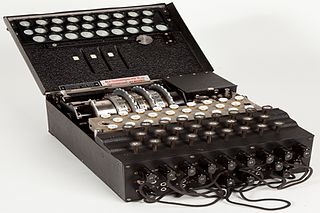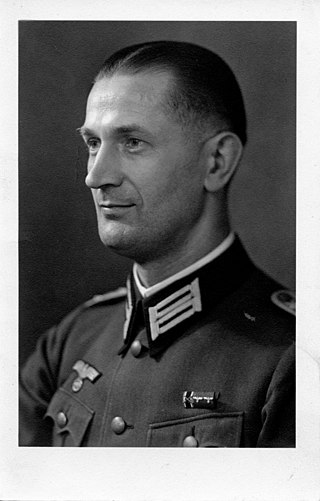
The Enigma machine is a cipher device developed and used in the early- to mid-20th century to protect commercial, diplomatic, and military communication. It was employed extensively by Nazi Germany during World War II, in all branches of the German military. The Enigma machine was considered so secure that it was used to encipher the most top-secret messages.

Ultra was the designation adopted by British military intelligence in June 1941 for wartime signals intelligence obtained by breaking high-level encrypted enemy radio and teleprinter communications at the Government Code and Cypher School (GC&CS) at Bletchley Park. Ultra eventually became the standard designation among the western Allies for all such intelligence. The name arose because the intelligence obtained was considered more important than that designated by the highest British security classification then used and so was regarded as being Ultra Secret. Several other cryptonyms had been used for such intelligence.
TICOM was a secret Allied project formed in World War II to find and seize German intelligence assets, particularly in the field of cryptology and signals intelligence.

The bombe was an electro-mechanical device used by British cryptologists to help decipher German Enigma-machine-encrypted secret messages during World War II. The US Navy and US Army later produced their own machines to the same functional specification, albeit engineered differently both from each other and from Polish and British bombes.
The Cipher Bureau was the interwar Polish General Staff's Second Department's unit charged with SIGINT and both cryptography and cryptanalysis.

Cryptanalysis of the Enigma ciphering system enabled the western Allies in World War II to read substantial amounts of Morse-coded radio communications of the Axis powers that had been enciphered using Enigma machines. This yielded military intelligence which, along with that from other decrypted Axis radio and teleprinter transmissions, was given the codename Ultra.

Fritz Erich Fellgiebel was a German Army general of signals and a resistance fighter, participating in both the 1938 September Conspiracy to topple dictator Adolf Hitler and the Nazi Party, and the 1944 20 July plot to assassinate the Fuhrer. In 1929, Fellgiebel became head of the cipher bureau of the Ministry of the Reichswehr, which would later become the OKW/Chi. He was a signals specialist and was instrumental in introducing a common enciphering machine, the Enigma machine. However, he was unsuccessful in promoting a single cipher agency to coordinate all operations, as was demanded by OKW/Chi and was still blocked by Joachim von Ribbentrop, Heinrich Himmler and Hermann Göring until autumn 1943. It was not achieved until General Albert Praun took over the post following Fellgiebel's arrest and execution for his role in the 20 July attempted coup.

Gustave Bertrand (1896–1976) was a French military intelligence officer who made a vital contribution to the decryption, by Poland's Cipher Bureau, of German Enigma ciphers, beginning in December 1932. This achievement would in turn lead to Britain's celebrated World War II Ultra operation.
Albert Praun was a German general who became the Chief Signals Officer of the Wehrmacht during World War II.

The Signal Corps or Nachrichtentruppe des Heeres, in the sense of signal troops, was an arm of service in the army of the German Wehrmacht and Waffen SS, whose role was to establish and operate military communications, especially using telephone and radio networks.
The Cipher Department of the High Command of the Wehrmacht was the Signal Intelligence Agency of the Supreme Command of the Armed Forces of the German Armed Forces before and during World War II. OKW/Chi, within the formal order of battle hierarchy OKW/WFsT/Ag WNV/Chi, dealt with the cryptanalysis and deciphering of enemy and neutral states' message traffic and security control of its own key processes and machinery, such as the rotor cipher ENIGMA machine. It was the successor to the former Chi bureau of the Reichswehr Ministry.
General der Nachrichtenaufklärung was the signals intelligence agency of the Heer, before and during World War II. It was the successor to the former cipher bureau known as Inspectorate 7/VI in operation between 1940 and 1942, when it was further reorganised into the Headquarters for Signal Intelligence between 1942 and 1944, until it was finally reorganised in October 1944 into the GdNA. The agency was also known at the OKH/Gend Na, GendNa or Inspectorate 7 or more commonly OKH/GdNA. Inspectorate 7/VI was also known as In 7 or In/7 or In 7/VI and also OKH/Chi.

Ostwin Fritz Menzer was a German cryptologist, who before and during World War II, worked in the In 7/VI, the Wehrmacht signals intelligence agency, later working in that was the cipher bureau of the supreme command of the Nazi party, and later in Abwehr, the military intelligence service of the Wehrmacht. He was involved in the development and production of cryptographic devices and procedures, as well as the security control of their own methods.
Otto Buggisch was a German mathematician who, during World War II, was a cryptanalyst working in the cipher bureau, the Cipher Department of the High Command of the Wehrmacht (OKW/Chi) responsible for deciphering of the opposing forces Communications. He also dealt with the security control of own key procedures. Through research and revelations exposed by two Polish officers, late in the war, he recognized the true cryptographic weaknesses of the Enigma rotor cipher, key machine used by the German armed forces to encrypt their secret communications, in World War II.
Hans Oschmann was a German Army general and signals officer, who was involved in the early command of the German signal intelligence organization and would later become director of the cipher unit at the Reichswehrministerium Chiffrierabteilung, later the between 1932 and 1934. He was the son of General Albert Oschmann, who was considered an expert of motor transportation and field transportation within the operational theater.
The Funkabwehr, "Radio Defense Corps," was a radio counterintelligence organization created in 1940 by Hans Kopp of the German Nazi Party High Command during World War II. It was the principal organization for the monitoring of illicit broadcasts. The formal name of the organization was Funkabwehr des Oberkommandos der Wehrmacht (OKW/WNV/FU). Its most notable breakthrough occurred on 26 June 1941, when tracing teams at the Funkabwehr station at Zelenogradsk discovered the Rote Kapelle, an anti-Nazi resistance movement in Berlin and two Soviet espionage rings operating in German-occupied Europe and Switzerland during World War II. The Funkabwehr was dissolved on 30 April 1945.
Hans Karl Georg Heinrich Pietsch was a German mathematician who was most notable for being a director of the Mathematical Referat of the Wehrmacht signals intelligence agency, the General der Nachrichtenaufklärung during World War II.
Friedrich Boetzel was a Brigadier general of the army of the Bundeswehr. During World War II Boetzel was an intelligence officer who was Director of Operations of the Cipher Department of the High Command of the Wehrmacht from 1939 to 1943. His cover name there was Bernhard

German Army cryptographic systems of World War II were based on the use of three types of cryptographic machines that were used to encrypt communications between units at the division level. These were the Enigma machine, the teleprinter cipher attachment, and the cipher teleprinter the Siemens and Halske T52,. All were considered insecure.

X, Y & Z: The Real Story of How Enigma Was Broken is a 2018 book by Dermot Turing about the Enigma machine, which was used by Nazi Germany in World War II, and about the French, British, and Polish teams that worked on decrypting messages transmitted using the Enigma cipher.









